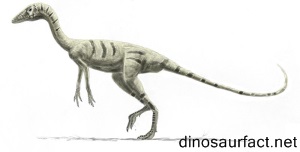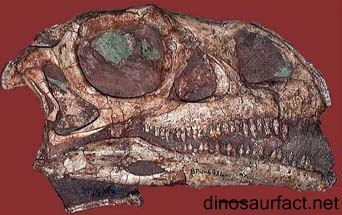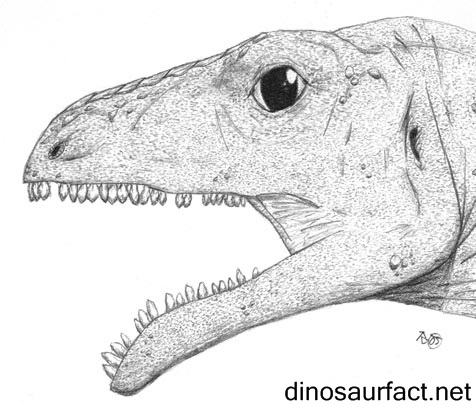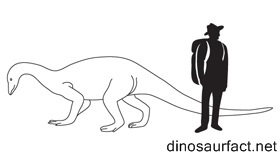 Click to visit the previous dinosaur bio
Click to visit the previous dinosaur bio
 |
|
 |
|
Kingdom: Animalia
Phylum: Chordata
Class: Sauropsida
Superorder: Dinosauria
Suborder: Sauropodomorpha
Family: Massospondylidae
Genus: Coloradisaurus
 |
|
 |
|
 |
|

The Coloradisaurus dinosaur (Colorados lizard) is named after the Los Colorados Formation. It is believed to have lived during the Late Triassic period in South America in present day Argentina, especially in the La Rioja Province. It lived approximately 230 to 206 million years ago. It was an omnivorous dinosaur. It was a member of the sauropod type of dinosaurs. These dinosaurs are the largest to have roamed the earth in primitive times.
The Discovery of fossils
A nearly complete skull is all that was found in the upper section of the Los Colorado's Formation. The specimen holotype is
- PVL 5904: The fossils suggest that it belonged to the Norian to Rhaetian stages of the upper Triassic period. It was originally named by Jose Bonaparte in 1978, but since the name Coloradia suggested by him was already assigned to a moth, the dinosaur had to be renamed.
Dr. Jose Fernando Bonaparte was born in 1928 on the 14th of June in Rosario, Argentina. He is an Argentine paleontologist who is accredited with discovering an abundance of dinosaurs in South America. He started collecting fossils at an early age and also had created a museum in his hometown. He was curator of the National University of Tucuman and later became a senior scientist at the Bernardino Rivadavia Natural Sciences Museum.
David Lambert in 1983 first named the genus. The type species for the Coloradisaurus is Coloradisaurus brevis. New postcranial remains of the species have been identified. These include parts of the vertebral column, pelvis, lower limbs, an incomplete forelimb and a pectoral girdle.
LA Rioja Province
The La Rioja Province of Argentina is located in the west of the country. Excavations in this province have led to the discovery of the Riojasaurus dinosaur besides the Coloradisaurus by Bonaparte himself. Like the Coloradisaurus, the Riojasaurus too was a sauropod from the Late Triassic period. Thus it can be deduced that the La Rioja province was home to herbivorous or omnivorous sauropods from the Late Triassic period.
The Norian to Rhaetian stages of the late Triassic
The late Triassic is the last and final stage in the time history of the Triassic. The Norian stage is the middle phase of the Upper Triassic timeline. It lasted from approximately 228 to 208.5 million years ago (mya.). It was succeeded by the Rhaetian stage, which is the latest stage of the Late Triassic period. The Rhaetian stage is succeeded by the first stage of the Jurassic period. The Rhaetian stage lasted from 208.5 to 201.3 million years ago. It is in the Rhaetian stage that Pangaea began to break up. The Coloradisaurus is supposed to have lived through both these stages.
The Coloradisaurus is a sauropod belonging to the Massospondylidae family. These are characterized by long necks and tails, herbivorous food habits and large size. The Coloradisaurus skull could be an adult version of the Mussaurus, which was an herbivorous, prosauropod from Argentina. Since the skeletal remains of adult Mussaurus have not been discovered, it is difficult to distinguish between these two similar species. Another related dinosaur is the previously discussed Riojasaurus.
Physical features and anatomy
- The Coloradisaurus was a large animal, but not as large as other sauropods like the Supersaurus.
- Like other sauropods, it had a characteristic long neck and tail.
- It was approximately thirteen feet or four meters in length, from snout to tail.
- It usually walked on all fours, but it could walk on its two hind legs too.
- The approximate weight or height of the species is not known due to fossil remains of only the skull being present.
Recent studies on the Coloradisaurus
Cladistic analysis by Adam Yates in 2007, then 2010 and then again with Fernando. E Novas in 2011 revealed that the Coloradisaurus Brevis is primitive to the Glacialisaurus-Lufengosaurus clade.
About the Coloradisaurus
The Coloradisaurus was either herbivorous or omnivorous. The dinosaur was primarily quadradpedal. Since only the skull of the species has been found, a lot about the dinosaur is a mystery. Much about this dinosaur can still be studied by comparing it with the other known sauropods from the Upper Triassic, data for some of which can be found in abundance. The specimen of the Coloradisaurus brevis is slender and more gracile compared to other sauropods of its time.
It was a terrestrial animal, feeding mostly off the leaves of tall trees due to its elongated neck. Being a rather large animal, the Coloradisaurus despite being an herbivore, was not usual prey to carnivores. It belongs to the category of reptiles, like majorly all dinosaurs. The teeth from the skull do give credibility to the claims of the animal being herbivorous. Some studies suggest that these dinosaurs used to live in packs or groups. They were nomadic and not territorial animals, i.e. they did not claim territories or settle at one place for a large period of time.
The Coloradisaurus is one of the more important sauropod dinosaurs. However, to distinguish between the other genera of dinosaurs, we need to find more fossils and skeletal evidence. The Coloradisaurus is also key to understanding the significant changes that occurred during the Rhaetian stage. The species could have been present at the time of the breaking of the Pangaea and could help us understand the ecological changes that took place around that time.
This could be vital in analyzing the effects of geology on the extinction of dinosaurs. Unfortunately, only one specimen of the dinosaur has been found and identified till date, making it difficult to ascertain significant information. Also, the question of whether or not the Coloradisaurus and the Mussaurus juveniles are from the same species remains unanswered.
The majesty of these dinosaurs is befitting the mystery that surrounds them. More excavations can only help us with more information about the Coloradisaurus and other such dinosaurs. Newer ways of analyzing skeletal remains and fossils and improvements in carbon fossil dating can have a huge impact in determining important and significant events and elements in the time history of the earth.
Index
Extinct Profiles
 Triassic Dinosaurs
Triassic Dinosaurs Jurassic Dinosaurs
Jurassic Dinosaurs Cretaceous Dinosaurs
Cretaceous Dinosaurs Pterosaurs
Pterosaurs Marine Reptiles
Marine Reptiles Dinosaur Extinction
Dinosaur Extinction